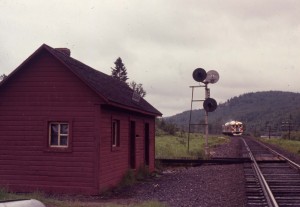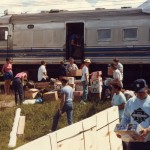The Former Station at Sheahan and the Budd Car
Going to Pog and going by train have been synonymous for me as long as I can remember. The building of the Canadian Pacific Railway in 1884 created the possibility for a place like Pog. For my family, the opportunity came in 1929 when my grandfather found a mill site at Wye, the CPR stop that was a short distance to Lake Pogamasing. Having the railway there was critical. It was as simple as no railway, no camp on Pog.
The transcontinental rail line was built by the Canadian Pacific Railway, a company formed to connect central Canada to British Columbia. Its primary purpose was to create an east-west link to keep various parts of the young Dominion from being lured by the stronger commercial pull from the United States. For our story, the railway was built through the Pogamasing area in August of 1884 but had a devastating impact on the Anishnabe and the fur trade.
A century ago, there were three daily passenger trains going in either direction across the country: it  was the era when the railway was the only feasible way to travel. The first trains were powered by steam engines which powered freight and passenger cars from coast to coast. By the 1930s there were two passenger trains a day, and after the Second World War, it was reduced to a daily service. For campers using the train to go to Pog, there were a couple of periods when we even got to use either the ‘Dominion’ or the ‘Canadian’. These were the most upscale transcontinental passenger lines that CP operated and we could travel in style to our stop at Sheahan, sitting in the cocktail lounge or riding in the dome car. As passenger numbers declined, the two national rail lines (CP and CN) transferred the declining passenger service to the government-owned VIA Rail. CP and CN kept the more lucrative freight service.
was the era when the railway was the only feasible way to travel. The first trains were powered by steam engines which powered freight and passenger cars from coast to coast. By the 1930s there were two passenger trains a day, and after the Second World War, it was reduced to a daily service. For campers using the train to go to Pog, there were a couple of periods when we even got to use either the ‘Dominion’ or the ‘Canadian’. These were the most upscale transcontinental passenger lines that CP operated and we could travel in style to our stop at Sheahan, sitting in the cocktail lounge or riding in the dome car. As passenger numbers declined, the two national rail lines (CP and CN) transferred the declining passenger service to the government-owned VIA Rail. CP and CN kept the more lucrative freight service.
The train we use today to travel to Pog is the Budd Car. The ‘Budd’, as it is affectionately known by the locals, consists of two self-propelled aluminum-clad vehicles, one a passenger car, the other a baggage car (on busier days, an extra passenger car is added). It has been in service for five decades or so on the run between Sudbury and White River. Unlike its earlier predecessors, the Budd only runs three times a week: westerly on Tuesday, Thursday and Saturday, and easterly on Wednesday, Friday and Sunday, with Mondays off.
An attraction of the train ride has always been the social experience as the Budd car has become the community centre for the rail line communities. The two-hour trip from Sudbury to Sheahan gives us time to chat with our friends on the lake, and people we get to know up the line. With only three trips a week we’re bound to be on the same train as others we know. It’s created that special bond with those who travel the Budd and the time we spend chatting helps minimize the delays we often experience. There might be plenty of seats in the passenger cars, but the first-class ones are in the baggage car.
And there’s more to the transportation story because just getting to the railway stop at Sheahan is only half the trip. Getting to the lake is a whole new challenge, and believe me, it’s where the excitement really begins. Everything isn’t perfect as you will discover in the chapter ‘Going to Pog’.
Postscript: This Year (2020) Frank Stark completed a master’s thesis at Ryerson University in partial fulfillment of the requirements for the degree of Master of Fine Arts entitled: TOWARDS INCLUSION: THE BUDD CAR TRAIN FROM SUDBURY TO WHITE RIVER. You can see his photos from his website: https://frankstarkimages.weebly.com/





{ 2 comments… read them below or add one }
Having been an Engineer on the Budd Car for about four years I was very pleased to see the picture of the old “Station” at Sheahan. I don’t know if you knew that the old station was burned down and a new one was built almost before the ashes from the burnt one were cool. It was an interesting detail that could be added to the story.
Thanks for your response Leo. I was aware that the old station was burnt down and have mentioned it in my book. I also have photos of the old station with the outer boards ripped off, so it wasn’t a very pretty sight. We thought the new ‘shack’ was in response to our howls of protest, although I don’t know the real reason why the CPR built it. I have written much more about the importance of the railway in a chapter “Going to Pog” that describes the importance of the railway to communities like Pogamasing.
Andy